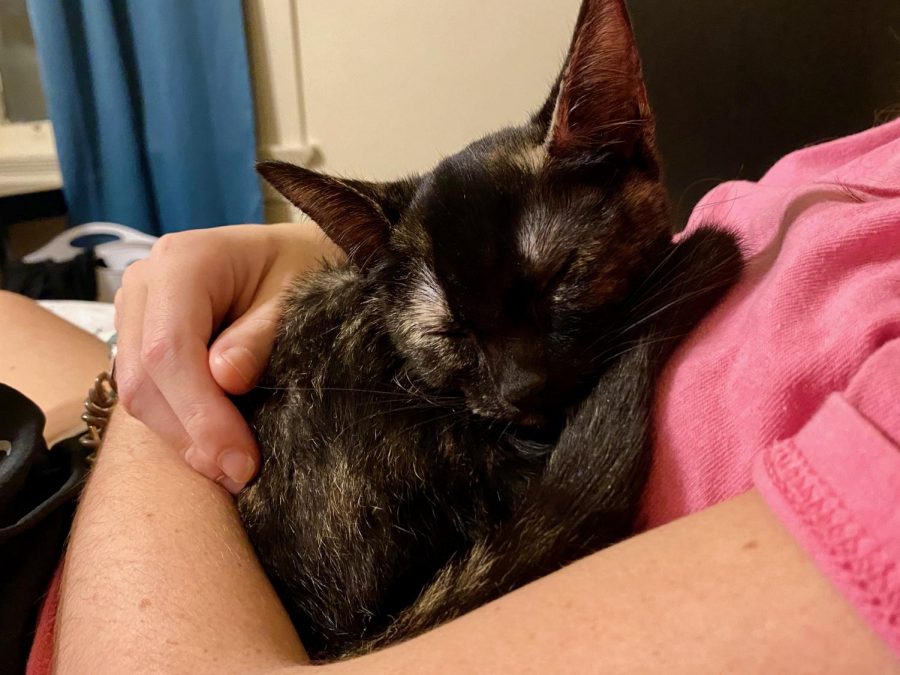Emotional support animals gain visibility at Tulane
October 21, 2020
On a quick stroll around Tulane’s campus on a nice day, it is difficult to miss the high number of furry companions accompanying students. Many of the animals are emotional support animals, meant to help maintain stability and routine for their owners. In recent years, colleges around the country have seen a sharp increase in the number of requests for students to bring their pets to live with them on-campus.
According to the Americans with Disabilities Act, an emotional support animal or comfort animal is an animal whose presence provides companionship, relieves loneliness and is often used as part of a medical treatment plan as therapy animals. Unlike service animals, ESAs are not required to not have special training to perform tasks to assist people with disabilities and only require a letter from a licensed medical professional.
Service animals, however, undergo extensive training before being paired with a handler. The tasks a service animal performs are directly related to their handler’s disability and are deemed a medical necessity. Service animals receive special protections under federal law that grant them public access, whereas emotional support animals’ protections are limited to housing and travel.
Because these technical distinctions between emotional support animals and service animals are not common knowledge, people often try to pass off their emotional support animals as service animals. This has resulted in what many describe as an “epidemic” of fraudulent service animals, which poses a serious problem for handlers who use service animals in their daily life.
“I feel like as a Deaf and disabled woman who has a guide dog people often mistake service dogs with emotional support animals,” senior Amy Vertacnik said. “I think many of the issues I face are because of emotional support animals. If I get a hesitant shop or restaurant owner, I always ask them why. They’ll often say a ‘service dog’ had an accident in their store or bit someone. I calmly tell them the dog in question was not a service dog and explain to them that there isn’t a universal licensing system for service dogs. This makes service dog fraud very real and common.”
Nonetheless, emotional support animals benefit many students on campus.
“I have had issues with anxiety and depression for a lot of my life, compounded when I was 14-15 by an autism spectrum diagnosis,” junior Kamryn Pigg said, who lives with her emotional support cat in Sharp Residence Hall. “There have been times in my experience in college where I felt alone, like no one understood me, and that I shouldn’t go on. Every single time, I had Khoshekh … No matter how bad the failed test, no matter how difficult the day, at night Khoshekh is a comforting weight on my chest and she purrs and I feel like maybe it will be okay.”
Senior Bridget Lee echoes these sentiments regarding her emotional support dog, Harriet.
“Harriet grounds me while in a state of panic, and she is usually the only thing that will pull me out of being triggered,” Lee said. “She makes me laugh when I need a laugh, she makes me feel loved when I need to feel loved, and she comforts me when I need comfort.”
The process of bringing an emotional support animal to live on campus is relatively easy and the Goldman Center has proven very supportive of students who request to live with an ESA, Pigg said.
“My therapist, even before I came to college, requested that I have an animal in order to help with my anxiety issues … So I just asked the Goldman Center,” Pigg said. “I had to get a letter from both my therapist and my psychiatrist, proving that I had a demonstrated need. Other than that it was very simple.”
Sophomore Annalisa Teleha, who is towards the end of the process of bringing her emotional support dog to live with her on campus, says the process has taken her a little over a month.
“To get an ESA on campus I first had to contact the Goldman Center to make them aware of my situation,” Teleha said.
Then Teleha had to request a letter from her psychiatrist regarding her diagnosis that recommended a housing accommodation. Next, she requested a vet recommendation to speak to her dog’s temperance. Later, a Goldman Center representative reached out to meet with Teleha and discuss her mental health history, her relationships at school, her class attendance, schoolwork and how having an ESA would benefit her.
“After talking with each other for about an hour she told me I would hear back from her in 5-7 days,” Teleha said. “And this leads me to where I am now in the process.”
Senior and Resident Advisor Anusha Rahman said that not all dorms are conducive to owning an ESA, but that “more independent-living dorms, like Phelps/Irby or Aron” are more suited to the experience. While there are some drawbacks to on-campus living with an ESA, such as limited dorm space and fire alarms, overall living with an ESA, from a suitemate’s perspective, was a positive experience for Rahman.
“It was nice to be able to cuddle with my suitemate’s ESA when I had a tough day, and it was nice to take her on walks sometimes,” Rahman said.
The perks to owning ESAs, according to ESA handlers, far outweigh the drawbacks.
“I gained a new best friend,” Lee said. “Life is just a much less daunting task when you have a companion to do it with, even if that companion doesn’t pay rent or clean up after themselves.”
The article was updated on Oct. 22, 2020, at 7 p.m. to better reflect the fact that the Goldman Center was willing to speak with The Hullabaloo.










KittenKween • Oct 22, 2020 at 9:16 pm
The cat in the photo is really cute